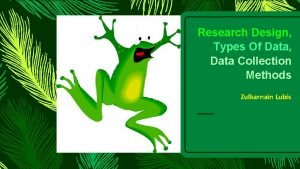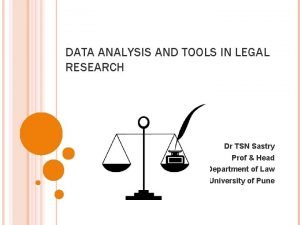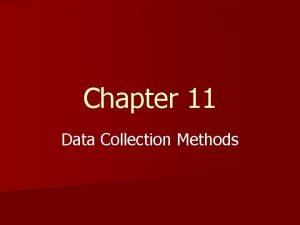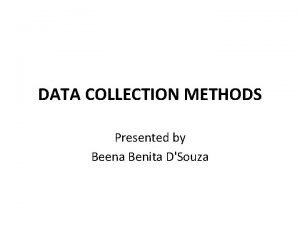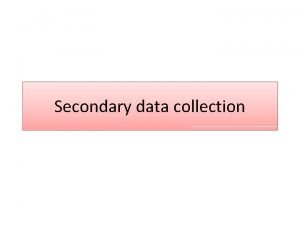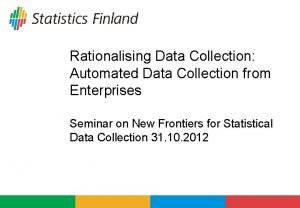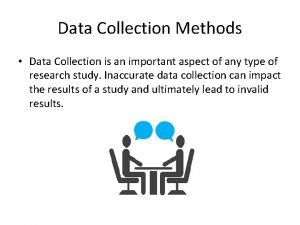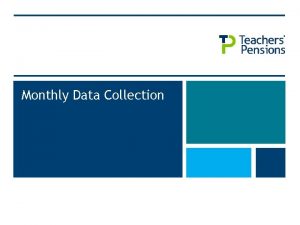Data Collection Methods 2 What is data Or







- Slides: 7

Data Collection Methods

2 What is data? Ø Or to be more accurate, what are data? [Data is plural!] Ø The data you collect are the evidence for your research, and it is the basis upon which you can make claims about the answer/s to your research question. Ø As with every aspect of research, it is important to be systematic about your data and how and when you will collect it. Ø This is why it is part of the process of research design. Ø There are numerous possibilities for methods of data collection, and sometimes you have to think about creating a particular kind of dataset to suit your research. But some of the most common methods are addressed in this PPT.

3 Data Collection Methods q q q q Lesson observation: detailed, focused observations of whole lessons, or predetermined parts of lessons; Interviews: probing conversations with interviewees to explore their perspectives, thinking, or reactions; Questionnaires: sets of questions which can be open-ended or closed which seek to elicit the perspectives, thinking, or reactions of participants ; Documents: the collection of relevant documents , such as historical archives or policy documents; Student work samples: examples of students’ work, written, oral or observed which provide information about students’ learning or progress ; Off-the-shelf tests/measures: pre-existing research tools, such as reading age tests; Pre and post test data: progress/performance measures captured ‘before’ and ‘after’ an intervention, or period of time; Purpose-built research tasks: tasks designed specifically to elicit a particular response eg a card sort to categorise different opinions.

4 Choosing your method q q q Choosing which data collection method to use is principally about matching the right data method to your research question, for example: Ø if you want to understand what teachers, or parents, or students think about something, then interviews are often a good method or deep exploration; Ø if you want to know something about classroom practice, either teacher practices or student responses, then classroom observation is useful; Ø if you want a large number of responses to gain a perspective on an issue, a questionnaire is useful; Ø if you want to examine the effectiveness of an intervention, pre and post test data is useful. Many research studies collect two or three complementary sets of data eg classroom observation and interviews; or large scale questionnaires followed by in -depth interviews; or pre and post test measures and classroom observation; If these data collection methods are well-designed and related to the research focus, they provide different spotlights on your research question: this is called triangulation.

5 Research Instruments Many of the data collection methods have an accompanying ‘research instrument’ or process for supporting the data collection Data Method Research Instrument Lesson observation Structured or semi-structured observation schedule Interviews Structured or semi-structured interview schedule Questionnaires Paper or online questionnaire Documents - Student work samples - Pre/post data A test or measure relevant to the research focus Off-the-shelf tests The test is itself an instrument More information about these methods and research instruments, with examples, is available on the website.

6 Research Instrument Design q The golden rule in creating your research instrument, for example, a semistructured interview schedule, is that it should be clearly focused on your research question; q You need to be clear what information/understanding/evidence you are trying to elicit; q You should think about the smaller ideas, or constructs, that you are probing through your research instrument; q You should draw, wherever possible on research and theoretical ideas in designing the research instruments. q More guidance on research instruments is available on the website.

7 Capturing Data q q q q Because most of the data methods described represent a moment in time which cannot be revisited, you need to think about how to capture your data so you can revisit it later for analysis. Sometimes the research instrument is itself a way of capturing your data, for example a questionnaire or an off-the-shelf test; But sometimes you need to think about ways to capture your data: audio recording is very useful for interviews; and video data is very useful for classroom observation; Designing a questionnaire online often cuts out a stage of transferring data on paper into an electronic format so is very useful; With tests and measures, you will need a clear system for recording the results, probably using EXCEL. Think about how you will capture your data before you begin data collection! Think also about the ethics of storing data: especially confidentiality and anonymity.
